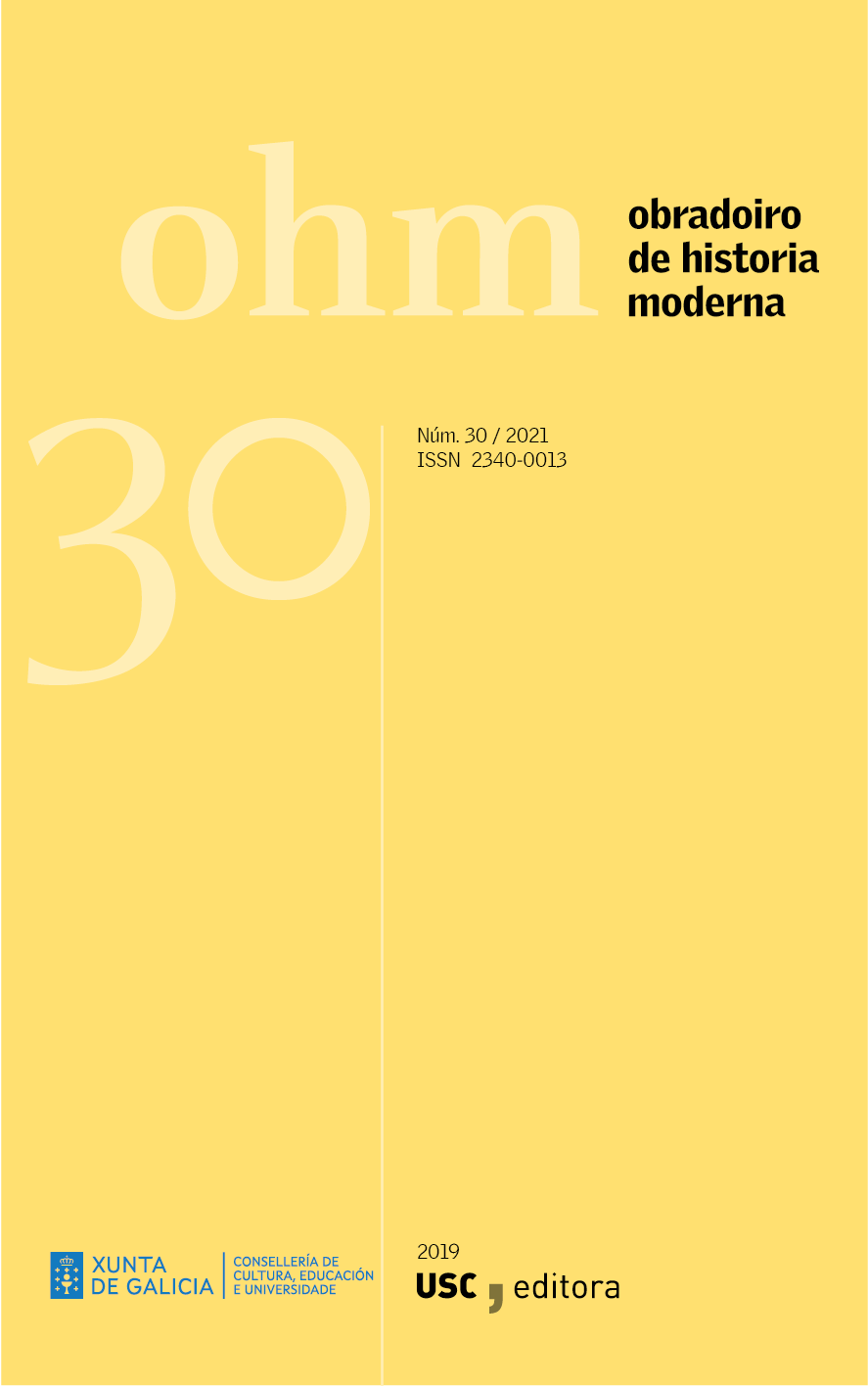Rivalry as an enemy. The efficience of the Flemish Army at the siege of Ostend, 1601-1604
Main Article Content
Abstract
During more than three years, the Army of Flanders sieged Ostend, the last stronghold of the Dutch Republic in the Spanish Netherlands. The location of the city, its continuous supply by sea, the weather conditions, the nature of the terrain, and the diversions of Maurice of Nassau’s army all hampered the reduction of the city. But they do not fully explain the delay. Rivalry between commanding officers and the different nations of the Army, insufficiently stopped by the captain general, also played an important role. This article analyzes how internal rivalry influenced the efficiency of the Army at Ostend.
Keywords:
Article Details
References
BENAVIDES, José Ignacio (2018), Spinola, capitán general de los tercios. De Ostende a Casal, Madrid, La Esfera de los Libros.
CARTER, Charles (1964), «Belgian ‘Autonomy’ under the Archdukes, 1598-1621», The Journal of Modern History, 36 (3), pp. 245-259. <https://doi.org/10.1086/239425>.
DANCKAERT, Laura (2019), «‘Groene geuzen’. Een casestudy naar de Unie van Hoogstraten (1602-1605) », Jaarboek Erfgoed Hoogstraten, 8, pp. 5-115.
DE VOS, Luc (1995), «Het Beleg van Oostende, 1601-1604», en De Vos, Luc (coord.), Veldslagen in de Lage Landen, Leuven, Davidsfonds, pp. 79-87.
DUERLOO, Luc (2012), Dynasty and Piety: Archduke Albert (1598-1621) and Habsburg Political Culture in an Age of Religious Wars, Farnham, Ashgate.
ELÍAS DE TEJADA Y SPÍNOLA, Francisco (1975), El Franco-Condado hispánico, Sevilla, Ediciones Turra.
ESTEBAN ESTRÍNGANA, Alicia (2012a), «Cabos de Guerra: satisfacción de la oficialidad y eficacia bélica en el Ejército de Flandes, entre los siglos XVI y XVII», en Pardo Molero, Juan Francisco y Lomas Cortés, Manuel (coords.), Oficiales reales. Los ministros de la Monarquía Católica (siglos XVI-XVII), Valencia, Universidad de Valencia, pp. 273-282. <https://doi.org/10.1163/9789004446267_008>.
ESTEBAN ESTRÍNGANA, Alicia (2012b), «Paréntesis bélico y reformación militar en el período de los Archiduques. Fundamentos de la acometida reformista de 1609», en García García, Bernardo José, Herrero Sánchez, Manuel y Hugón, A. (coords.), El Arte de la Prudencia. La Tregua de los Doce Años en la Europa de los Pacificadores, Madrid, FCA, pp. 425-485.
ESTEBAN ESTRÍNGANA, Alicia (2021a), «The ‘Perfect Principality’ of the Archdukes Albert and Isabella: Project and Reality of a ‘Separate Government’ of the Spanish Crown, 1529-1621», en De Bom, Erik, Lesaffer, Randall y Thomas, Werner (coords.), Early Modern Sovereignties: Theory and Practice of a Burgeoning Concept in the Netherlands, Leiden, Brill, pp. 167-217.
ESTEBAN ESTRÍNGANA, Alicia (2021b), «A Joab for King David. Ambrogio Spinola, General of Archduke Albert, and the Davidic Imaginary in Times of Philip III (1598-1605)», en Mostaccio, Silvia, García García, Bernardo José y Lo Basso, Lucca (coords.), Ambrogio Spinola between Genoa, Flanders and Spain, Lovaina, University Press Leuven [en prensa].
GONZÁLEZ DE LEÓN, Fernando (2009), The Road to Rocroi: Class, Culture and Command in the Spanish Army of Flanders, 1567-1659, Leiden & Boston, Brill. <https://doi.org/10.1163/ej.9789004170827.i-408>.
HELBIG, Henri (1868), «Bonours, Christophe de», Biographie nationale, t. 2, pp. 687-688.
HENRARD, Paul (1890), Histoire du siège d’Ostende (1601-1604), Bruselas, C. Muquardt.
LEFEVRE, Joseph (1923), «Les ambassadeurs d’Espagne à Bruxelles sous le règne de l’archiduc Albert (1598-1621)», Revue belge de philologie et d’histoire, 2, pp. 61-80. <https://doi.org/10.3406/rbph.1923.6213>.
LEFEVRE, Joseph (1924), «Le ministère espagnol de l’archiduc Albert, 1598-1621», Bulletin de l’Académie royale d’Archéologie de Belgique, 6 (2), pp. 202-224.
LOMBAERDE, Piet (2004a), «Oostende afgesneden, belegerd, opgegeven en ingenomen: 1599-1604», en De Vries, Dirk (coord.), Oostende verloren Sluis gewonnen, 1604. Een kroniek in kaarten, Leiden, Universiteitsbibliotheek, pp. 47-69.
LOMBAERDE, Piet (2004b), «De stad Oostende en de nieuwe gebastioneerde versterkingswijzen in de Nederlanden», en Thomas, Werner (coord.), De val van het Nieuwe Troje, Lovaina, Davidsfonds, pp. 47-57.
MALTBY, William S. (2011), Auge y caída del imperio español, Madrid, Marcial Pons, [traducción de Jesús Cuéllar Menezo].
PARKER, Geoffrey (1972), The Army of Flanders and the Spanish Road, 1567-1659, Cambridge, Cambridge University Press.
PICEU, Tim (2008), Over vrybuters en quaetdoenders. Terreur op het Vlaamse platteland (eind 16de eeuw), Lovaina, Davidsfonds.
RAEYMAEKERS, Dries (2013), One Foot in the Palace: The Habsburg Court of Brussels and the Politics of Access in the Reign of Albert and Isabella, 1598-1621, Lovaina, Leuven University Press. <https://doi.org/10.2307/j.ctt9qdwz4>.
RETORTILLO ATIENZA, Asunción (2017), Ambrosio Spínola, de Génova a Ostende (1569-1604), Madrid, Ministerio de Defensa.
SALAZAR Y ACHA, Jaime de (s.f.), «Silva y Mendoza, Rodrigo de», en Real Academia de la Historia, Diccionario Biográfico electrónico (en red, <http://dbe.rah.es/biografias/13880/rodrigo-silva-y-mendoza>).
THOMAS, Werner (1999), «La corte de Bruselas y la restauración de la casa de Habsburgo en Flandes, 1598-1633», en VV. AA., El Arte en la Corte de los Archiduques Alberto de Austria e Isabel Clara Eugenia (1598-1633). Un Reino Imaginado, Madrid, Sociedad Estatal, pp. 46-63.
THOMAS, Werner (2004a), «De val van het Nieuwe Troje», en Thomas, Werner (coord.), De val van het Nieuwe Troje, Lovaina, Davidsfonds, pp. 7-19.
THOMAS, Werner (2004b), «Het beleg van Oostende», en Thomas, Werner (coord.), De val van het Nieuwe Troje, Lovaina, Davidsfonds, pp. 81-99.
THOMAS, Werner (2011), «Jerónimo Gracián de la Madre de Dios, la corte de Bruselas y la política religiosa en los Países Bajos meridionales, 1609-1614», en Vermeir, René, Ebben, Maurits y Fagel, Raymond (coords.), Agentes e identidades en movimiento. España y los Países Bajos, siglos XVI-XVIII, Madrid, Sílex, pp. 289-312.
THOMAS, Werner (2014), «The ‘Spanish Faction’ at the Court of the Archdukes Albert and Isabella», en Vermeir, René, Raeymaekers, Dries y Hortal Muñoz, José Eloy (coords.), A Constellation of Courts: The Courts and Households of Habsburg Europe, 1555-1655, Lovaina, University Press Leuven, pp. 167-221. <https://doi.org/10.2307/j.ctt14jxsxk.9>.
THOMAS, Werner (2018), «Los ingenios del sitio de Ostende», Desperta Ferro, 36, pp. 18-22.
THOMAS, Werner (2020), «How a defeat became a victory: the siege of Ostend in contemporary Dutch war coverage and post-war chronicles (1601-15)», en Fagel, Raymond, Álvarez Francés, Leonor y Santiago Belmonte, Beatriz (coords.), Early modern war narratives and the Revolt in the Low Countries, Manchester, Manchester University Press, pp. 126-146.
VLIETINCK, Edward (1897), Het oude Oostende en zijne driejarige belegering, Oostende, Jos Vlietinck.







